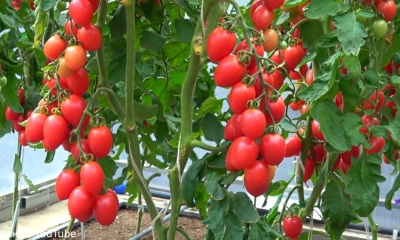
- Authors: Italy
- Name synonyms: Prince Borghese, Bourgeois Prince, Prince Borges
- Category: grade
- Growth type: indeterminate
- Appointment: for whole-fruit canning, for drying and drying
- Ripening period: mid-season
- Ripening time, days: 105
- Growing conditions: for greenhouses
- Marketability: high
- Transportability: Yes
Tomatoes of the Italian selection Prince Borghese, also found under the name Prince Borges, Prince Borghese, are highly valued by vegetable growers throughout Europe. Its fruits are excellent for curing, drying, canning, and add a spicy taste to dishes. This Mediterranean variety is unpretentious, subject to the rules of agricultural technology, it can be grown in most regions of the Russian Federation in all types of greenhouses, from film to glazed.
Description of the variety
Variety Prince Borghese forms tall, thin, but not fragile stems up to 180-210 cm. They are abundantly covered with foliage. The first inflorescences on the bushes are laid above 8-9 leaves. Fruit clusters contain 13-17 tomatoes, they are quite heavy and require tying after formation.
The main qualities of the fruit
Miniature tomatoes of the Prince Borghese variety have a dense, red-colored skin. Fruit weight reaches 30-35 g. The shape of each tomato is oval, with a small nose. They are calibrated and have excellent marketability.
Taste characteristics
The fruits have a recognizable, bright sweetness. The taste is pleasant, there are few seeds in the pulp, it is juicy and dense.
Ripening and fruiting
The variety is mid-season, long fruiting, lasts from July to September. The ripening period is 105 days.
Yield
The variety yields fruits up to 9-11 kg / m2. It is high-yielding and provides fairly good harvests in greenhouse conditions.
The timing of planting seedlings and planting in the ground
In the period from March 1 to March 15, Prince Borghese tomato seeds are sent to special containers or to a common container with fertile nutrient soil. They need to be deepened by 10 mm, lightly sprinkled with peat. Preliminary disinfection with manganese and soaking in a growth stimulator will allow you to get friendly shoots, prevent fungal infections. Plants are transferred to open ground closer to June 5, planting in the greenhouse can be started 3 weeks earlier.

Growing tomato seedlings is an extremely important process, because it largely depends on whether the gardener can harvest at all. All aspects must be taken into account, from seedbed preparation to planting in the ground.
Landing scheme
Plants are placed in a garden bed or in a greenhouse with an interval of 60 × 50 cm. There will be up to 3 bushes per 1 m2.

Growing and care
The variety requires formation of 1-2 stems. Tall shoots must be tied up to avoid overloading them. It is also better to remove stepsons. The lower leaves are completely cut off after full ripening 2 clusters of fruits.
Tomato seedlings Prince Borghese must be dived at the stage of appearance of 2 leaves. It is best grown in separate peat pots for easy transplanting. Watering young shoots too often should not be done, it is important to focus on the dryness of the soil, to introduce moisture in a timely manner.The seedlings are kept at home until 1 flower cluster appears. Until then, it is important to maintain 14 hours of daylight hours.
Ridges must be formed in a well-lit place so that during the ripening process the fruits receive a sufficient amount of sunlight. Cabbage and carrots, onions or turnips are considered to be good predecessor plants. After planting, the bushes are given 7 days to acclimatize. After that, watering is carried out 2-3 times a week, three times a month - pinching. Every month, the bushes are fed, alternating nitrogen, potassium and phosphorus fertilizers, as well as humates and other useful ingredients that improve the taste of fruits, accelerating their ripening.




A plant needs different micronutrients at each stage of growth. All fertilizers can be divided into two groups: mineral and organic. Folk remedies are often used: iodine, yeast, bird droppings, eggshells.
It is important to observe the rate and period of feeding. This also applies to folk remedies and organic fertilizers.
Disease and pest resistance
Plants of this variety are resistant to most fungal infections. Tomatoes have high immunity, and early ripening minimizes the risks of damage to the bushes by late blight.


Resistant to adverse weather conditions
In case of changes in atmospheric temperatures, fruit set remains at a high level. The variety is also not prone to cracking of the skin at high soil moisture. Prince Borghese is also resistant to heat, not afraid of growing in arid climates.
Review overview
The owners of summer cottages have already appreciated the Prince Borghese tomato variety. It is indicated that in the southern regions it is quite mature in the open field. Fruits are rated more like cherry, but in a greenhouse they can gain mass to cocktail. It is noted that they ripen from July to October, almost until the frost. If you keep a plant in 3-4 trunks, the yield is very high, but additional feeding will be required regular, without gaps.
As for the taste properties of the fruits, here Russian summer residents unequivocally support the opinion of Italian chefs, who consider Prince Borghese to be the best variety of tomatoes for drying and canning in oil.Tomatoes retain their taste, color and aroma perfectly after preservation. Green tomatoes ripen well on bushes torn from the ground and then suspended with their roots up.
Among the problems that arise when growing these tomatoes, one can single out a very high growth rate. If you do not pinch the top, you can get a giant stem taller than 3 m.

























































































